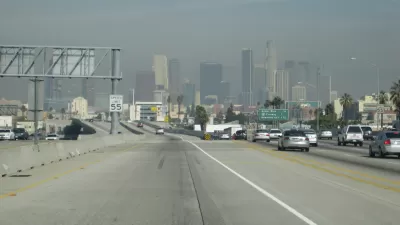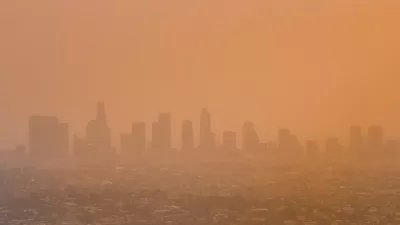A new study by NOAA scientists and colleagues shows a stunning reduction in vehicle-related air pollutants in the Los Angeles basin over the past several decades. Despite the gains, unhealthy air remains.
The recent paper, published in the Journal of Geophysical Research, shows a dramatic 98 percent drop in air pollution from motor vehicles since the 1960s, despite a threefold increase in the use of gasoline and diesel fuel over the same period. The chemicals tracked by the researchers, called volatile organic compounds (VOCs), are primarily emitted from the tailpipes of vehicles, and "are a key
ingredient in the formation of ground-level ozone," writes the National Oceanic and Atmospheric Administration.
"The magnitude of the drop in VOC levels was surprising, even to
researchers who expected some kind of decrease resulting from
California's longtime efforts to control vehicle pollution."
"Even on the most polluted day during a research mission in
2010, we measured half the VOCs we had seen just eight years earlier," said Carsten Warneke, Ph.D., a NOAA-funded scientist with the Cooperative Institute for Research in Environmental Sciences (CIRES) at the University of Colorado Boulder. "The difference was amazing."
Despite the improvements in vehicle emissions, attributed to "requirements for catalytic converters, use of reformulated fuels less
prone to evaporate, and improved engine efficiency of new vehicles," overall ozone levels in L.A. have not fallen as steeply. "Ozone pollution in the
Los Angeles Basin has decreased since the 1960s, but levels still don't
meet ozone standards set by the Environmental Protection Agency."
FULL STORY: NOAA, partners find 50-year decline in some Los Angeles vehicle-related pollutants

Maui's Vacation Rental Debate Turns Ugly
Verbal attacks, misinformation campaigns and fistfights plague a high-stakes debate to convert thousands of vacation rentals into long-term housing.

Planetizen Federal Action Tracker
A weekly monitor of how Trump’s orders and actions are impacting planners and planning in America.

In Urban Planning, AI Prompting Could be the New Design Thinking
Creativity has long been key to great urban design. What if we see AI as our new creative partner?

King County Supportive Housing Program Offers Hope for Unhoused Residents
The county is taking a ‘Housing First’ approach that prioritizes getting people into housing, then offering wraparound supportive services.

Researchers Use AI to Get Clearer Picture of US Housing
Analysts are using artificial intelligence to supercharge their research by allowing them to comb through data faster. Though these AI tools can be error prone, they save time and housing researchers are optimistic about the future.

Making Shared Micromobility More Inclusive
Cities and shared mobility system operators can do more to include people with disabilities in planning and operations, per a new report.
Urban Design for Planners 1: Software Tools
This six-course series explores essential urban design concepts using open source software and equips planners with the tools they need to participate fully in the urban design process.
Planning for Universal Design
Learn the tools for implementing Universal Design in planning regulations.
planning NEXT
Appalachian Highlands Housing Partners
Mpact (founded as Rail~Volution)
City of Camden Redevelopment Agency
City of Astoria
City of Portland
City of Laramie




























